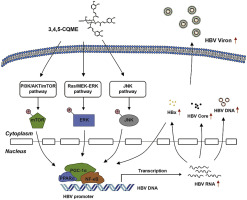Food and Chemical Toxicology ( IF 3.9 ) Pub Date : 2020-03-07 , DOI: 10.1016/j.fct.2020.111250 Haoqiang Wan , Lanlan Ge , Lingyun Xiao , Jiemei Li , Weigang Wu , Shusong Peng , Jian Huang , Boping Zhou , Xiaobin Zeng

|
Caffeoylquinic acids are well known for their prominent antiviral activities. Beyond our expectations, we initially found 3,4,5-Tri-O-caffeoylquinic acid methyl ester (3,4,5-CQME) from L. japonica can facilitate HBV DNA and antigens secretion. This study aimed to investigate its underlying molecular mechanism. The results indicate that 3,4,5-CQME signally increased intracellular and secreted HBsAg levels by more than two times in HepG2.2.15 cells and HepAD38 cells. Furthermore, levels of HBeAg, HBV DNA and RNA were significantly enhanced by 3-day 3,4,5-CQME treatment; it didn't directly affect intracellular cccDNA amount, although it slightly increased cccDNA accumulation as a HBV DNA replication feedback. In addition, treatment with 3,4,5-CQME significantly induced HBx protein expression for viral replication. We utilized a phospho-antibody assay to profile the signal transduction change by 3,4,5-CQME to illuminate its molecular mechanism. The results indicate that treatment with 3,4,5-CQME activated AKT/mTOR, MAPK and NF-κB pathways verified by immunoblot. Moreover, 3,4,5-CQME upregulated the expression of nuclear transcriptional factors PGC1α and PPARα. In short, 3,4,5-CQME promotes HBV transcription and replication by upregulating HBx expression and activating HBV transcriptional regulation-related signals. As caffeoylquinic acids are widely present in traditional Chinese medicines, the risk of intaking caffeoylquinic acids-containing herbs for hepatitis B treatment requires more evaluation and further research.
中文翻译:

从忍冬忍冬中分离得到的3,4,5-三-O-咖啡酰奎尼酸甲酯。花芽促进乙肝病毒在HepG2.2.15细胞中复制
咖啡酰奎尼酸以其突出的抗病毒活性而闻名。出乎我们的意料,我们最初从粳稻中发现了3,4,5-Tri-O-咖啡酰奎尼酸甲酯(3,4,5-CQME)可以促进HBV DNA和抗原的分泌。这项研究旨在调查其潜在的分子机制。结果表明,在HepG2.2.15细胞和HepAD38细胞中,3,4,5-CQME信号地增加细胞内和分泌的HBsAg水平两倍以上。此外,通过3、3、4、5-CQME治疗3天,HBeAg,HBV DNA和RNA水平显着提高。尽管它稍微增加了作为HBV DNA复制反馈的cccDNA积累,但它并没有直接影响细胞内cccDNA的数量。另外,用3,4,5-CQME处理可显着诱导HBx蛋白表达以进行病毒复制。我们利用磷酸化抗体分析来分析3,4,5-CQME的信号转导变化,以阐明其分子机制。结果表明,用3,4,5-CQME活化的AKT / mTOR处理,MAPK和NF-κB通路已通过免疫印迹验证。此外,3,4,5-CQME上调了核转录因子PGC1α和PPARα的表达。简而言之,3,4,5-CQME通过上调HBx表达并激活HBV转录调控相关信号来促进HBV转录和复制。由于咖啡酰奎尼酸广泛存在于中药中,因此服用含咖啡酰奎尼酸的草药进行乙型肝炎治疗的风险需要更多评估和进一步研究。











































 京公网安备 11010802027423号
京公网安备 11010802027423号